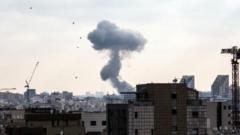Is Iran Planning Retaliation Now, Later, or Never?

Understanding Iran's Response to US Airstrikes: Strategic Options and Implications
In the wake of the recent US airstrikes on three nuclear sites in Iran, the Islamic Republic has vowed to pursue "everlasting consequences," igniting a fervent debate within its security and intelligence circles. This article delves deep into the multifaceted strategic options available to Iran post-strike, exploring the potential ramifications of each choice while considering the internal and external pressures that influence Iran's decision-making. As tensions escalate, understanding Iran's possible responses becomes crucial for anticipating developments in the region and the global community.
The Current Landscape: A Tense Standoff
The airstrikes have not only provoked a furious reaction from Iran, but they have also intensified an ongoing exchange of fire between Iran and Israel, which has entered its tenth day. Iran’s leaders face the dilemma of whether to retaliate against US interests or to seek negotiations, a move that would likely require concessions on their nuclear program. As discussions unfold among Iranian commanders, the fear of potential Israeli precision airstrikes looms large, complicating their strategic calculus.
Iran's Strategic Dilemma
Iranian leaders are contemplating three primary courses of action in response to the US airstrikes:
- Retaliatory Attacks: Engaging in direct military retaliation against US assets in the region.
- Proxy Warfare: Utilizing allied groups and militias to launch attacks against US interests while maintaining plausible deniability.
- Diplomatic Negotiations: Seeking to re-establish diplomatic ties and discussions, albeit under challenging conditions dictated by the US and Israel.
Each of these strategies carries inherent risks and potential repercussions, particularly regarding the survival of the Iranian regime and its influence in the region.
1. Retaliatory Attacks: A High-Stakes Gamble
Direct retaliation against US military installations poses a significant risk not just for Iran, but for the entire Middle East. Retaliatory actions could escalate into a broader conflict, drawing in regional and global powers. Iran possesses a considerable arsenal, reportedly maintaining around 1,500 to 1,500 missiles, which could be directed toward one of approximately 20 US military bases scattered across the region.
Potential Targets for Retaliation
When contemplating a retaliatory strike, Iran will consider several potential targets:
- US Navy's Fifth Fleet in Bahrain: This base serves as a strategic hub for US naval operations in the Gulf, making it a prime target.
- Isolated Bases in Iraq and Syria: Bases such as At-Tanf, Ain Al-Asad, and Erbil are seen as vulnerable and could be targeted using proxy forces.
- US Naval Vessels: Iran could conduct "swarm attacks" using drones and fast boats, overwhelming US defenses through sheer numbers.
Such attacks could inflict significant damage but would undoubtedly provoke a strong US military response. The memory of the Iranian response to the assassination of Qassim Suleimani in 2020 serves as a cautionary tale; while Iran retaliated, it did so with restraint, avoiding US casualties.
2. Proxy Warfare: The Shadowy Alternative
Another strategic avenue for Iran involves leveraging its network of allied militias and proxy forces across the region. This approach allows Iran to engage in asymmetric warfare, striking at US interests without direct involvement, thus minimizing the risk of immediate retribution.
Utilizing Proxy Forces
Iran has a history of utilizing proxies effectively. Some possible avenues include:
- Militias in Iraq: Groups such as Kata'ib Hezbollah and other Shiite militias could launch attacks on US personnel and installations.
- Support for Palestinian Factions: Iran could increase support for groups in Gaza, potentially escalating tensions with Israel.
- Yemen's Houthis: The Houthis could be directed to resume their attacks on shipping in the Red Sea and Gulf of Aden.
This approach allows Iran to maintain a degree of plausible deniability, complicating US responses. However, it also risks entangling Iran in broader regional conflicts and could lead to retaliatory strikes against Iranian territory.
3. Diplomatic Negotiations: A Path to De-escalation?
In light of the heightened tensions, Iran might consider re-engaging in diplomatic negotiations with the US. However, any discussions would come with significant caveats, particularly regarding Iran's nuclear program. The US and Israel have made it clear that for Iran to retain its civil nuclear program, it must agree to export its enriched uranium.
Challenges to Diplomatic Engagement
Several factors complicate this potential route:
- Domestic Pressure: The Iranian regime faces pressure to respond decisively to perceived humiliation, making concessions politically risky.
- US Demands: The requirement to relinquish uranium enrichment poses a fundamental challenge to Iran's nuclear ambitions.
- Regional Dynamics: The delicate balance of power in the Middle East complicates any diplomatic overtures, especially as Gulf Arab states cautiously engage with Iran.
While a return to negotiations could ease tensions, it would require significant concessions from Iran, which may not be politically feasible given the current climate.
Economic Targets: Choking Off the Strait of Hormuz
Beyond military and diplomatic strategies, Iran could consider targeting key economic infrastructure as a means of retaliation. The Strait of Hormuz, a crucial maritime chokepoint through which over 20% of the world’s oil supply passes, represents a significant lever for Iran.
Potential Economic Strategies
Iran's economic targets could include:
- Mining Operations: Deploying sea mines in the Strait of Hormuz could disrupt shipping, creating a substantial economic crisis.
- Cyber Attacks: Utilizing its advanced cyber capabilities to disrupt US networks or economic institutions is another option, potentially causing widespread chaos.
While such actions could inflict damage on US and global interests, they would likely draw swift retaliation, further destabilizing the region.
Cyber Warfare: A Covert Response
In the modern landscape of warfare, cyber capabilities play a crucial role. Iran has developed sophisticated offensive cyber capabilities, allowing it to potentially target US infrastructure, businesses, and governmental operations.
Potential Cyber Strategies
Iran might consider various cyber operations, including:
- Destructive Malware Insertion: Deploying malware to disrupt critical US infrastructure could be executed when tensions have subsided.
- Targeting Diplomatic Missions: Cyber attacks could extend to embassies and consulates, disrupting operations and communications.
- Assassination Operations: Targeting individuals of interest through cyber means could escalate tensions without direct military confrontation.
However, engaging in cyber warfare carries the risk of provoking a significant US response, particularly if American assets or personnel are harmed.
Conclusion: The Path Forward for Iran
The airstrikes have placed Iran at a critical juncture, where its decisions could have far-reaching implications for regional stability and its own regime's survival. Each of the strategic options available comes with its own set of risks and potential consequences, making the decision-making process exceedingly complex.
Whether Iran chooses to retaliate, utilize proxy forces, or re-engage in diplomatic negotiations, the underlying goal will be to maintain its influence and ensure the survival of the Islamic Republic. The coming days and weeks will reveal how Iran navigates this precarious landscape, balancing the need to respond decisively with the desire to avoid a broader conflict that could threaten its existence.
Frequently Asked Questions
What are the potential consequences of Iran retaliating against US interests?
Retaliation could escalate into a broader conflict, drawing in regional powers and leading to a potential military response from the US. It could also destabilize the region further and impact global oil markets.
How might Iran use proxy forces to its advantage?
Iran could leverage allied militias in Iraq, Yemen, and other regions to conduct attacks on US interests while maintaining plausible deniability, thus minimizing direct retaliation risks.
Is there a possibility of diplomatic negotiations between Iran and the US?
While diplomacy remains a possibility, it would require significant concessions from Iran, particularly regarding its nuclear program. The domestic and regional pressures may complicate this path.
As the situation continues to develop, one must consider: will Iran prioritize military retaliation, economic disruption, or diplomatic engagement to navigate this crisis? #Iran #USForeignPolicy #MiddleEastTensions
Published: 2025-06-22 14:46:03 | Category: technology



